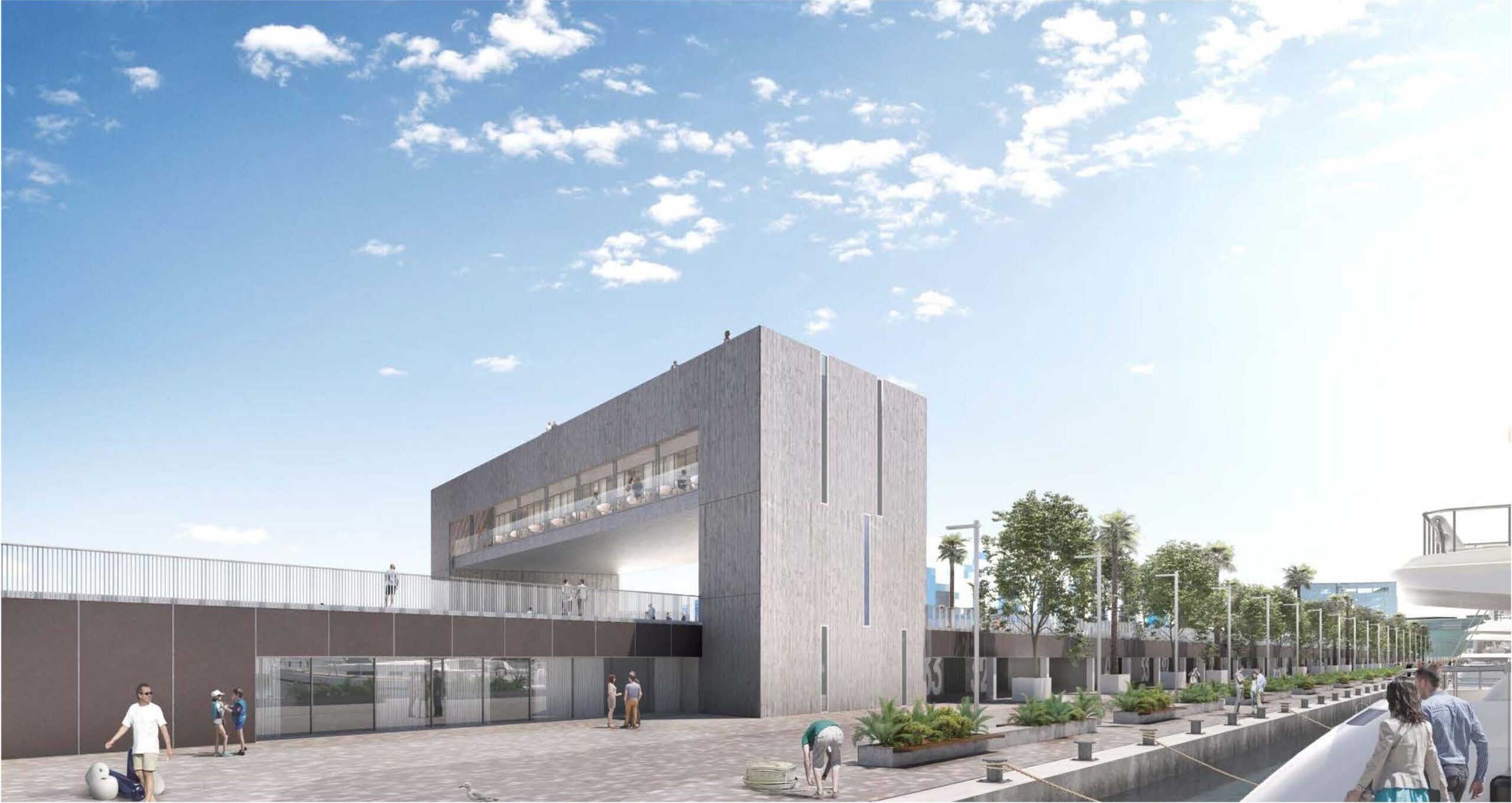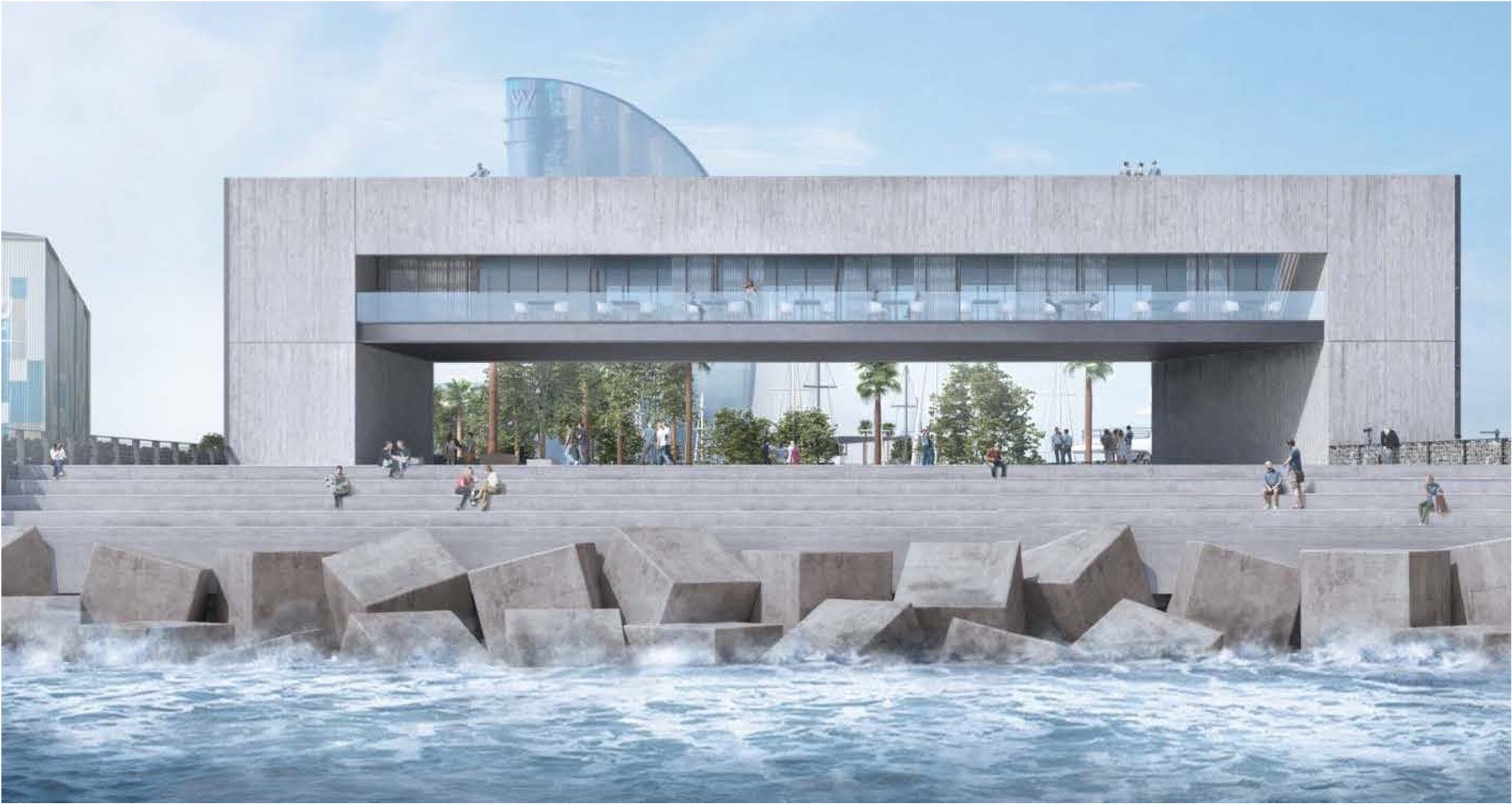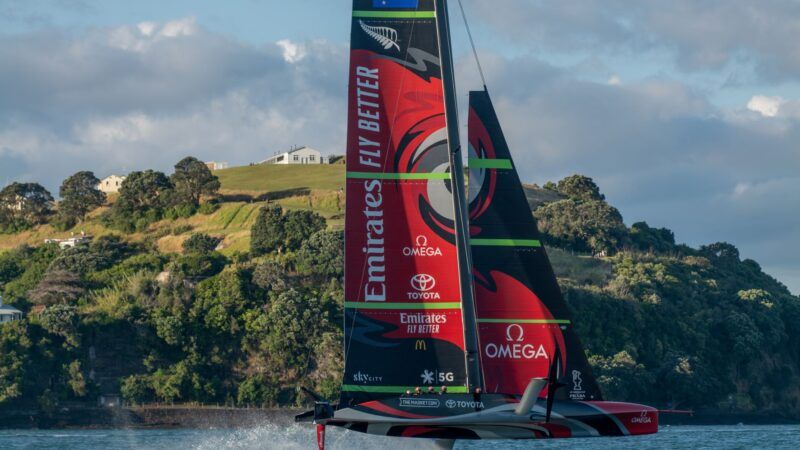 The America's Cup has already "started" in Barcelona with the arrival of the teams and the start of construction work (Emirates Team New Zealand).
The America's Cup has already "started" in Barcelona with the arrival of the teams and the start of construction work (Emirates Team New Zealand).
The transformative effect of the America’s Cup for the Port of Barcelona
In addition to sport and prestige, a sporting event of the scale of the America's Cup has an economic and urban lasting impact on the host city. The biggest change that the Port of Barcelona will undergo will be in the Port Vell, but unlike in previous editions, no new infrastructures will be built, but rather existing ones will be updated and transformed. We explain how and compare it with other ports hosting the competition.
 The America's Cup has already "started" in Barcelona with the arrival of the teams and the start of construction work (Emirates Team New Zealand).
The America's Cup has already "started" in Barcelona with the arrival of the teams and the start of construction work (Emirates Team New Zealand).
In just over a year's time, Barcelona will host the 37th edition of the world's most prestigious regatta. The activity related to the America's Cup has already begun in the city with the arrival of the participating teams and the start of construction work, will intensify in November 2024, and its legacy will continue in the years to come.
David Pino, director of the Port Vell, explains that the differing factor with previous editions is the readaptation, and not the construction, of existing spaces destined for the bases of the six participating teams and which could later be used for other purposes, once the event is over.

Why?
As the general manager of the Port of Barcelona, José Alberto Carbonell, explained in an article in La Vanguardia, "for a port to have the necessary infrastructure to host the six participating teams is practically impossible (...) For this reason, the proposals (to host events such as the America's Cup) are often based on building costly infrastructures, linked to complex urban transformations that are more chimerical than necessary. Faced with this reality, public administrations are increasingly reluctant to promote these risky transformation processes, because, in addition, they are watched over by a society that is increasingly demanding in terms of cost-benefit analysis." And he concluded his reflection in the article by pointing out the importance of the collaboration between the public sector, which basically leads, plans and manages, and the private sector, "with companies that have assumed as their own the capacity to make such an important event possible, has been the key to present the initial offer and especially to allow a location of the six teams very well distributed throughout the length and breadth of the Port Vell."

An economic, social and environmental dimension
The Port of Barcelona's strategic decision to host the America's Cup has sought long-term sustainability in three areas: economic, environmental and social.
The decision to refurbish and transform and not to build is more sustainable from an economic point of view, but the Barcelona edition also involves a novelty in this sense, as David Pino explains:
"Those in charge of financing and building the bases are, unlike other editions, the teams themselves. The organisation will provide the services, sewage, accesses or connections they require by land and sea. We commissioned a technical guide for the bases, specifying, for example, national fire and emergency regulations. The teams presented us with their projects, which, due to time constraints, we had to approve quickly.”
The bases will also implement several environmental measures proposed by the Port of Barcelona: a photovoltaic system, regenerated water and a carbon footprint analysis to offset CO2 emissions.
With relation to the connection with the public, Pino explains that the intention of both the Port of Barcelona and the city council is to open up not the beaches, as happened during the Olympics, but the sea and the water activities, including those related to the blue economy.
"That is why we have offered the best space we can offer as the Port Authority of Barcelona: the Moll de la Fusta, which will be the great stage where the free public village will be located during the two months of the regatta. This measure will help to bring closer sailing, the sea and everything related to the maritime in the city," Pino emphasises.

The reshaping of the America's Cup bases
The location of the six bases in the Port Vell underwent a modification with respect to the initial one. "The first proposal we put forward was to use the spaces in the Moll Adossat, past the cruise terminal, and to set up all the bases together, which was the model used in other editions."
However, the start and finish of the regattas would be located in the Bocana Comercial, which reduced Barcelona's candidacy. "After the visit of Grant Dalton, director of Team New Zealand, the organisers of this edition, we rethought the proposal and proposed to distribute the bases around the Port Vell and look for larger spaces, as they need more than half a hectare with a connection to the water, and complex characteristics," he shares.
This decision has meant changes in the Port's maritime and commercial traffic. However, the impulse that the America's Cup represents to activate public and private projects is an opportunity that neither administrations nor private partners wanted to miss. "The sum of confluences and efforts to fit the bases in spaces that will allow a series of projects to be launched was a unique opportunity," says Pino.
The bases of the 6 teams will implement environmental measures proposed by the Port of Barcelona: a photovoltaic system, regenerated water and a carbon footprint analysis to offset CO2 emissions
The urban interventions of the America's Cup in Barcelona
Twenty actions are planned for the second major remodelling of the Port Vell after the 1992 Olympic Games.
David Pino highlights some of the most significant and complex ones, directly or indirectly related to the installation of the bases in the city:
- Moll de Pescadors: "It is an area where specific activities take place, which must be respected and must have continuity. All the structures that will be put in place will be new, modern and very different from the current ones, and will be managed by the Fishermen's Guild."
- Transfer of the operations from the Barcelona Nord pier to Adossat and the change of cruise ship and Baleària operations, speeding up the agreements reached with Barcelona City Council in 2018 regarding the moving of cruise ship activity away from the city centre.
- The refurbishment of the Tinglados, which will house the Port of Barcelona's hospitality facilities.
- The Nova Bocana complex, which includes several actions such as the construction of an elevated promenade, the new Mirador building, which will connect the new promenade with the Moll de Ribera, and the development of the esplanades, currently in disuse.
In total, 120 million euros will be invested in these and other actions. Pino explains that the deadlines for the completion of the set of interventions will be carried out as planned for each one of them.
What transformations were carried out in other America’s Cup venues?
David Pino explains that they consulted with other previous America's Cup venues to learn from their experience, as well as with the organisers. "We have asked, listened and learned. It has helped us to better understand what the America's Cup needs, especially the participating teams, although we have given it a twist to adapt it to the Barcelona style. This learning is reflected in, for example, the fact that the investment will be 95% profitable," he says.
Pino goes on to cite the cities that have served as examples for the organisation of the 37th America's Cup:
Auckland: America's Cup without barriers
The shared vision of the Government, Auckland Council and Emirates Team New Zealand for the 36th America's Cup was an inclusive event, with a waterfront that allowed an accessible experience connected the public to the boats, bases and events, in a linear village that stretched along the waterfront from the East Viaduct, to North Wharf and Wynyard Point.
To achieve this visibility and connection, 12 tanks were removed from Wynyard Wharf and 19th century industrial infrastructure was released from the urban space. A new breakwater was also placed alongside Hobson's Wharf to make the waters of the harbour outside the viaduct calm enough for ships to launch safely.
In Auckland's newly opened Viaduct Harbour, where the village was located, the America's Cup sailing facilities were integrated into a new mixed-use urban extension for the city, where the 2000 and 2003 America's Cup was held.
“From Auckland we learnt that we had to make things very easy and try to be very agile in, for example, managing permits," Pino explains.
Valencia: complete regeneration of the port
Since Valencia was selected as the venue for the 32nd edition, the Valencia 2007 Consortium took on the main task of remodelling the port of Valencia to make it the best setting for the nautical event.
The result of this redevelopment was the Juan Carlos I Royal Marina, located right in the centre of Valencia, to the north of the commercial port and next to the Malvarrosa beach, which was transformed into a large space for the public.
The Veles e Vents building, designed by architect David Chipperfield, was also built for spectators t and now houses a Michelin-starred restaurant and various spaces for different uses.
"We had several conversations with Valencia about their experience. In urban planning terms, they made very good use of the event, with the opening of the port. In a way, their America's Cup was our Olympics," he says.
San Francisco, democratisation of regattas
The 34th edition held in the Californian city was the first time in history that the races were visible from multiple locations, both on land and at sea, with the start and finish lines located on the northwest waterfront.
The presence of additional boats in the bay waters prompted the installation of a temporary power supply at Pier 27. Large private yachts and race-sponsored vessels were required to use low-emission fuels to reduce environmental impact.
Piers 30-32, which before the event was a concrete slab on crumbling pilings, was transformed into a bayfront amphitheatre and sailing showplace, a revitalised boardwalk that runs along the Bay Bridge to the south of AT&T Park.
"Both in San Francisco and the later edition, held in Bermuda, the democratisation of sailing and the absence of barriers to enjoy the event was paramount," recalls Pino.
As can be seen, the America's Cup is a major event that drives and revolutionises the ports and cities that host it, and leaves a technological, urban and management imprint. This is also the case for the Port and Barcelona because, as the Port Vell manager explains, the teams, made up of between 100 and 140 people, are already in the city and he stresses that they have expressed their satisfaction with the bases and their rapid integration with the city, suppliers and other local companies.




